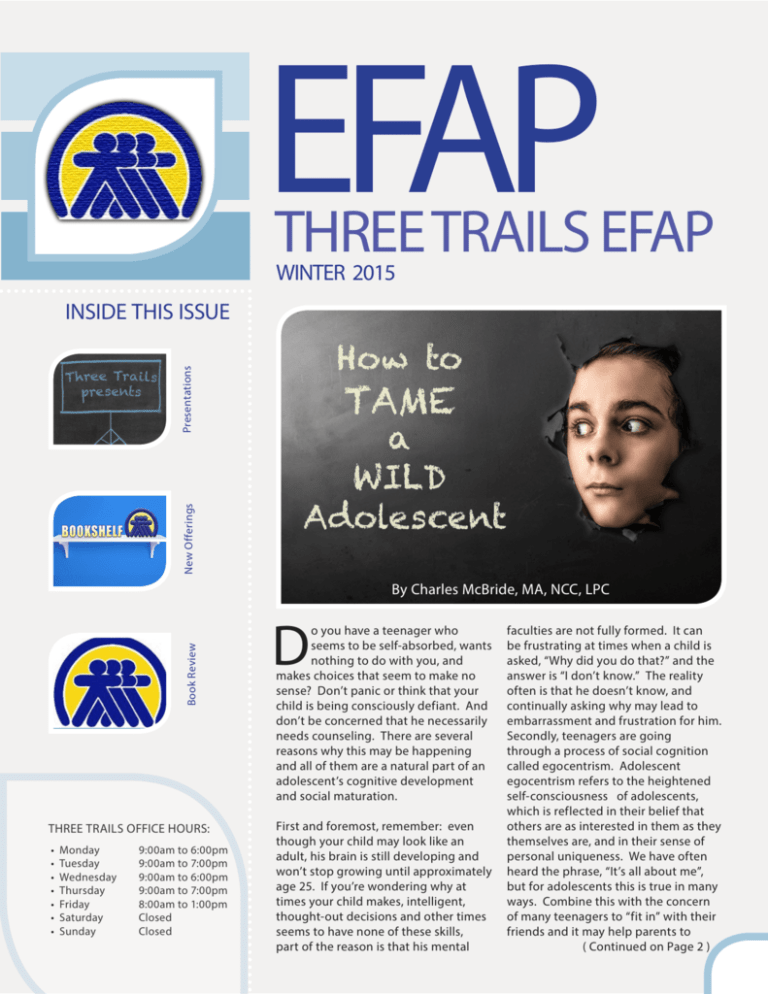winter 2015 - Three Trails EFAP
advertisement

EFAP THREE TRAILS EFAP WINTER 2015 New Offerings Presentations INSIDE THIS ISSUE Book Review By Charles McBride, MA, NCC, LPC THREE TRAILS OFFICE HOURS: • • • • • • • Monday Tuesday Wednesday Thursday Friday Saturday Sunday 9:00am to 6:00pm 9:00am to 7:00pm 9:00am to 6:00pm 9:00am to 7:00pm 8:00am to 1:00pm Closed Closed D o you have a teenager who seems to be self-absorbed, wants nothing to do with you, and makes choices that seem to make no sense? Don’t panic or think that your child is being consciously defiant. And don’t be concerned that he necessarily needs counseling. There are several reasons why this may be happening and all of them are a natural part of an adolescent’s cognitive development and social maturation. First and foremost, remember: even though your child may look like an adult, his brain is still developing and won’t stop growing until approximately age 25. If you’re wondering why at times your child makes, intelligent, thought-out decisions and other times seems to have none of these skills, part of the reason is that his mental faculties are not fully formed. It can be frustrating at times when a child is asked, “Why did you do that?” and the answer is “I don’t know.” The reality often is that he doesn’t know, and continually asking why may lead to embarrassment and frustration for him. Secondly, teenagers are going through a process of social cognition called egocentrism. Adolescent egocentrism refers to the heightened self-consciousness of adolescents, which is reflected in their belief that others are as interested in them as they themselves are, and in their sense of personal uniqueness. We have often heard the phrase, “It’s all about me”, but for adolescents this is true in many ways. Combine this with the concern of many teenagers to “fit in” with their friends and it may help parents to ( Continued on Page 2 ) “One of the main tasks of adolescence is to achieve an identity—not necessarily a knowledge of who we are, but a clarification of the range of what we might become, a set of self-references by which we can make sense of our responses, and justify our decisions and goals.” - Terri Apter Altered Loves Latest Library Additions • The Scarred Soul; Understanding & Ending Self-Inflicted Violence by Tracy Alderman, Ph.D. • Common Threads of Teenage Grief by Teens Who Know & Janet N Tyson • Unglued; Making Wise Choices in the Midst of Raw Emotions by Lysa Terkeurst • The Mindfulness Workbook for Addiction; A Guide to Coping with the Grief, Stress, and Anger that Trigger Addictive Behaviors by Rebecca E Williams, Ph. D. & Julie S. Kraft, MA How to Tame a Wild Adolescent understand why the same child who wants to express himself as an individual may dress and act just like his friends. Again, this is a natural developmental phase. Adolescent egocentrism can be split into two types of social thinking— imaginary audience and personal fable. The imaginary audience refers to the heightened self-consciousness of adolescents as mentioned above. It involves attention-seeking behavior— the desire to be noticed, visible and “on stage”. Adolescents especially sense that they are “on stage” in early development , believing they are the main actors and all others are the audience. The personal fable is the part of adolescent egocentrism involving an adolescent’s sense of uniqueness. This makes them feel that no one can understand how they really feel. This is why an adolescent girl may think her mother cannot possibly sense the hurt she feels because her boyfriend broke up with her. Finally, adolescents go through a period when they think they’re indestructible. This is called the invincibility fable. Many teenagers behave as if they’re coated with Teflon. When they jump off of roofs or, when older, race cars on city streets, they (cont. pg. 1) truly believe nothing will happen to them. This belief is pervasive; even if a schoolmate dies from an accident, the adolescent thought process says, “Well, it couldn’t happen to me”. Rest assured, this too is a developmental process that most children grow out of. So, how do you tame a wild adolescent? As with all other stages of childhood, it takes patience and understanding. Do you just let them run wild? No. They need and, if truth be told, want your guidance, respect and especially, love. But if you keep in mind that they are still growing and maturing, your relationship may be stronger when they come out on the other end. However, if or when problems do occur, the counselors at Three Trails are happy and available to assist. (Further information on the cognitive development of adolescents and especially adolescent egocentrism can be found at facweb.bch.edu) 2014 Three Trails EFAP Survey results are in!! Thank you so much to those who participated in the 2014 Three Trails Adult & Child Survey. We value your feedback to improve the quality and effectiveness of our service. It helps us to identify areas that need improvement and lets us know when we are on the right track! ”Common sense is the collection of prejudices acquired by age eighteen.” - Albert Einstein “Maturity is when your world opens up and you realize that you are not the center of it.” - M.J. Croan - You are invited to take advantage of free and insightful presentations offered by Three Trails EFAP Staff Allow us to help you and your employees with these initial professional presentations! In the future, fully researched and developed, interactive presentations might include such topics as: the handling of stress over the holidays, developing a comprehensive wellness plan, parenting skills utilizing the Love and Logic modalites, the setting of healthy boundaries, general stress management, grief/loss management, anger control, recognizing the signs of abuse and healthy parenting techniques. If you know of any presentations that would be beneficial for your worksite, please email your ideas to us at threetrails@threetrailsefap.org. “Healthy Communication in the Workplace” Charles McBride MA, NCC, LPC “Beware of the Darker Side of Empathy” Jamie Day MA, NCC, LPC This presentation will provide employees working in various settings with tools on handling disagreements with co-workers as well as ways to achieve effective communication with peers within your workforce. This presentation will focus on explaining symptoms of burnout, compassion fatigue and vicarious trauma as well as providing ideas of preventive wellness that individuals can use to keep these at bay. The 5 Love Languages: The Secret to Love that Lasts A book review by Bonda Zeller, LPC, NCC If you have never had the opportunity to read about love languages, this may be the place to begin for you and your partner. Author Gary Chapman describes his discovery and understanding of how individuals feel, give, and receive love. The book includes practical examples of situations that arise in relationships and how to act from a loving perspective. The author defends that each person is loved exclusively with: Gifts, Quality Time, Acts of Service, Words of Affirmation and Physical Touch. He writes “Your emotional love language and the language of your spouse may be as different as Chinese from English.” He supports the idea that each individual has a primary language, and that rarely is ours the same as our companions. Learning to use another love language or dialect to express love or to teach someone your dialect takes practice, but will open communication. I was exposed to the love languages in a workshop about showing volunteers appreciation. Just as this book does, it helped me to recognize how knowing someone’s love language can help you to uplift others, in an organization or in a relationship. More information and other love language books are available at Three Trails EFAP or on the author’s website at www.5lovelanguages.com/. Attention Deficit Hyperactivity Disorder Among Children From The National Institute of Mental Health Attention deficit hyperactivity disorder (ADHD) is one of the most common childhood disorders and can continue through adolescence and into adulthood. Symptoms include difficulty staying focused and paying attention, difficulty controlling behavior, and hyperactivity (over-activity). Additional information about ADHD can be found on NIMH’s extensive website. See: www.nimh.nih.gov “Adolescence is like having only enough light to see the step directly in front of you.” - Sarah Addison Allen The Girl Who Chased the Moon “Snow and adolescence are the only problems that disappear if you ignore them long enough.” - Earl Wilson - “First you have to survive adolescence; then your education. Finally, yourself.” - Marty Rubin -











